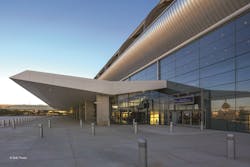After more than a decade of planning, design, and construction, the Phoenix Sky Harbor International Airport opened Stage 1 of the PHX Sky Train to customers on April 8. The people-mover system allows one of the country’s busiest airports to alleviate roadway congestion and enhance customer service while serving as a prototype for airports seeking modern transit solutions.
The initial 1.92-mile-long PHX Sky Train segment includes three elevated passenger stations, and it links the Phoenix region’s 44th Street Metro light rail station with the airport’s economy parking area and the 88-gate Terminal 4. The layout and operation of the system is designed to be intuitive and simple, creating a high level of service and convenience for passengers with facilities that are well integrated into the airport and the surrounding community.
Overcoming challenging site constraints, the elevated people-mover system weaves seamlessly through the airport’s 3,000 acre, three-runway grounds.
“As with most airports, Sky Harbor was not laid out with the intent of integrating an intermodal transit system in the future. The congested site required many innovative solutions during the project’s design and construction,” said Mark Pilwallis, P.E., senior project manager for Gannett Fleming based in the firm’s Phoenix office.
One major project obstacle was the location of Taxiway Romeo, an active runway that was directly in the guideway’s path. To provide the optimal guideway alignment into the Terminal 4 Station, the guideway needed to cross over the taxiway. While the team first considered routing the people-mover under the taxiway, this more expensive approach offered significant challenges, including a complex underground environment of utilities.
Only an elevated system would provide the most efficient alignment. The design and planning process required intense coordination with the Federal Aviation Administration (FAA) to develop criteria that would be acceptable.
“There were no predetermined design benchmarks or examples to follow. The team was called upon to develop and present detailed criteria to the FAA,” Pilwallis stated.
Ultimately, the FAA approved the above ground solution. The guideway crosses over Taxiway Romeo, the first time in the world that a transit bridge has been used to cross an active taxiway. The bridge is high enough to allow a 747 to pass underneath. It is 90 feet above the taxiway, and the columns supporting it are as deep under the ground as they are tall — up to 125 feet in some locations.
With goals for sustainability and long-term flexibility, the electrically powered, automated PHX Sky Train encourages patrons to utilize alternative transportation by connecting Terminal 4 to Metro light rail. It is expected to reduce the airport’s greenhouse gas emissions by nearly 6,000 tons a year, and three stations will use 30 percent less power than established normal baselines. The project has been LEED Gold Certified by the U.S. Green Building Council, making it the only LEED certified public transportation campus in the world.
“The team’s sustainable design solution positions Sky Harbor for success. Roadway and curb side congestion is alleviated, passengers experience easier connections to the surrounding community, and green building features exemplify the airport’s commitment to the environment,” Pilwallis said.
For Stage 1, Gannett Fleming served as the fixed facilities design engineer. Kimley-Horn & Associates served as civil engineer; Dinter Engineering provided mechanical, electrical, and plumbing engineering services; and HOK provided architectural design services. Hensel Phelps served as construction manager.
An extension of the PHX Sky Train to connect the remainder of the terminals is underway and is scheduled to open in 2015. A future second phase of the PHX Sky Train program will add an additional 2.5 miles of guideway and connect to the rental car center. The full PHX Sky Train system will create a modern and efficient transportation system capable of serving the needs of the airport, its passengers, and the local community long into the future.



